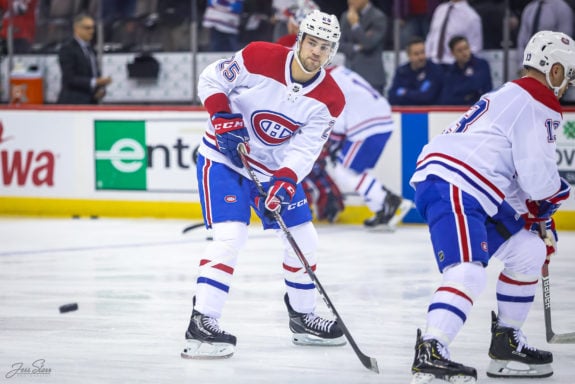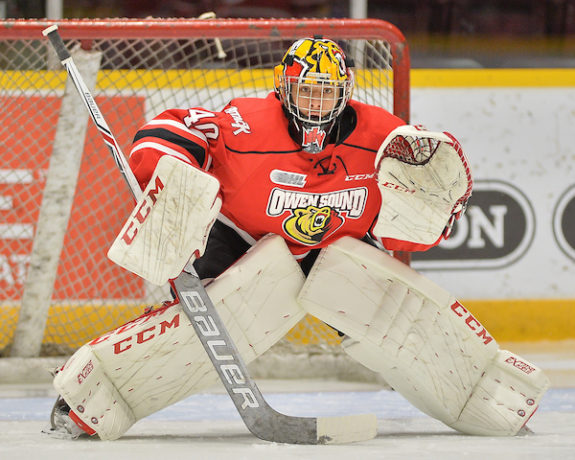Coming off a surprise Stanley Cup Final run cut short by a Tampa Bay Lightning squad that is arguably the best team ever assembled in the salary cap era, the Montreal Canadiens general manager (GM) Marc Bergevin returned to the 2021 NHL Entry Draft focused on adding to the team’s prospect pool.
Fueled by 39 draft picks since the 2018 Draft, which includes 17 in the top 90, the Canadiens’ prospect pool is the deepest it has been in over a decade. Instead of ranking prospects in a traditional ranking system of one through 10 or even 25, instead, this exercise will rank prospects in a tiered pyramid.
Definition of a Prospect
For this exercise, I will use the definitions laid out by Corey Pronman of The Athletic, which defines prospects as:
“A skater no longer qualifies as an NHL prospect if he has played 25 games in the NHL in any campaign, regular season and playoffs combined, or 50 games total; or reaches age 27 by Sept. 15. A goalie no longer qualifies as an NHL prospect if he has played 10 games in the NHL in any campaign, regular season and playoffs combined, or 25 games total; or reaches age 27 by Sept. 15.”
From: “Pronman: 2020-21 NHL Organizational Rankings” 11/9/20
Using this as the basis to follow, names such as Nick Suzuki, Jesperi Kotkaniemi and Alexander Romanov no longer apply. Adding them to this pyramid would greatly improve the outlook of the prospect pool for the team, despite all of them being 21 years old, but they do not meet the standards set in the definition.
How is the Pyramid Tiered
A pyramid is arguably as subjective as a traditional ranking system, but the pyramid will look at overall potential instead of arguing why Prospect A is ranked 11th instead of Prospect B.
The Tiers are as follows:
Tier 1 – Elite or top-line, top-pair talent
Tier 2 – Top-six forward, top-four defender, starting goaltender
Tier 3 – Third-line forward, bottom-pair defender, backup goaltender
Tier 4 – Role players, bottom-line forward, depth defenceman or forward
Tier 5 – Minor league player used for call-ups
Tier 1
It’s lonely at the top for Cole Caufield, the only Canadiens prospect to be in this tier. The 2021 Hobey Baker Award winner fits well into this tier for a few reasons. The first, his ability to score. He has only 30 games of NHL experience — 20 were in the playoffs and over that time he rose to a top-line role. He enters the 2021-22 season still eligible for the Calder Trophy as the league’s top rookie and can be seen as a favorite to compete for the nomination. Competing for the award is also a goal for him as he tells Arpon Basu of The Athletic:
“Yeah, that’s something that you only get one chance at in your career, so it is a big goal of mine. Obviously, there’s a lot of things that go into that, but it will always be in the back of my mind. I’m not going to worry too much about it because I’m obviously playing to win, but I think that’s something that everybody works for. For me, personally, it’s a goal for me that I’ll be hoping to get.”
– Cole Caufield (Cole Caufield QandA:Canadiens rookie on receiving the Hobey Baker Award, breaking into the NHL and what’s next, Arpon Basu, The Athletic, 20/8/21)
He is expected to be an impact player in Montreal for many years to come.
Tier 2
The expectation here is for players rated in this tier to become top-six forwards, top-four defenders or a starting goaltender. The Habs have a handful of these prospects, and this tier will be extremely important in the ultimate goal for the Canadiens to become a contending team. True contenders have these players graduating regularly and producing early on, allowing their impact to be felt while their salaries are still low.
Jesse Ylonen, Kaiden Guhle, Cayden Primeau, Jayden Struble, Jordan Harris, Luke Tuch, Logan Mailloux, Matthias Norlinder, and Jan Mysac all fall in this tier.
Guhle, the team’s 2020 first-round pick, is set for a big season developmentally. He is to be the top defender and captain of the Prince Albert Raiders, he is in the running to be captain of Team Canada at the World Junior Championships (WJC). He is projecting to be a physical, complete, two-way defender at the NHL level.

Tuch being included here may surprise some followers. However, even as a freshman, the 6-foot-2, 203-pound power forward became a top offensive weapon for Boston University, finishing third in team scoring while playing on the top line and earned power-play responsibilities as well. He will be a project, but his progression points to him being able to become a second-line power forward like his brother, Vegas Golden Knights forward Alex Tuch.
Norlinder and Mysac are bordering into this tier. They have the talent to be in this tier, but questions remain if they can reach it. The hope for the Canadiens this fall is that Norlinder can, as he is expected to, enter training camp and compete for a roster spot on the blue line. As a puck-moving defenceman, he has a skill set that is in dire need in Montreal and he will have every opportunity to show he can be an NHL defenceman. That being said, it is more likely he returns to Europe for another year of development.
The player that could have the largest impact in the future in this tier is Primeau. As the only goaltender in the system who is seen as a potential NHL starting goalie, he will be an important prospect to focus developmental assets on as he is still not NHL ready. With Carey Price entering the last few seasons of his career, there is no rush to push Primeau’s development, which should allow him to ease into his potential position in time.
Tier 3
This tier may not seem as important for the Canadiens’ long-term success, but quality bottom-six forwards and bottom-pair defenders do play key roles on contending teams.
In this tier we see Ryan Poehling, Josh Brook, Lukas Vejdemo, Sean Farrell, Riley Kidney, Raphael Harvey-Pinard, and Oliver Kapanen.
One player, Poehling, could become the most impactful from this tier. As a large-framed, two-way center, his skill set fits perfectly with the prototype of the third-line center contenders look for. In his last American Hockey League (AHL) season, he was Laval Rocket’s top center, playing in every situation. He provided speed, physical play, leadership, defensive play with offensive production. If he can translate that to the NHL, the Canadiens’ 2017 first-round pick will become a key contributor. With Phillip Danault’s departure, the role as a defensive center is available.

Kapanen is an interesting prospect here as he has a rare skill set in the Habs’ system: he can score. He will get more opportunities to show he can as European teams return to full schedules, and he is in the running for Finland’s WJC team.
Tier 4
It is still necessary to have young, inexpensive options to fill the bottom of an NHL lineup. Some may be able to display skill sets that can earn them full-time NHL jobs and even earn larger roles, especially when injuries become a concern.
This tier has players like Cam Hillis, Dmitri Kostenko, Frederik Dichow, Blake Biond, Rhett Pitlick, Joshua Roy, William Trudeau, Joe Vrbetic, Joel Teasdale, Micheal Pezzetta and Gianni Faibrother.
Teasdale is here as an undrafted player who earned an NHL entry-level contract after leading his junior team to a Memorial Cup. However, he suffered a season-ending knee injury in training, missing the entire 2020 season. Then in the following season, suffered another season-ending knee injury. If he eventually hopes to compete for an NHL job he will need to have a full season injury free.
Pezzetta is a solid energy player who can play a bottom-six role. He could become an option as a call-up for the Canadiens; that being said, he will be very important in Laval as a complementary middle-six player as well as a physical enforcer to discourage others from taking liberties with the younger prospects entering the professional ranks.
Tier 5
Brett Stapely, Micheal McNiven, Jacob Oloffson, Jack Gorniak, Arvid Henrikson, Xavier Simoneau, Jack Smith, Arsen Khisamutidinov fill out this level of the pyramid.

The Canadiens have replenished their prospect pool with some very good prospects. Some, if given the right development opportunities might surprise, move up and surpass expectations. However, the current situation for Montreal’s prospects is that there is only one that is seen as a top-tier impact player. The rest fall into secondary and depth roles, which can be very useful for a team that is looking to add quality skilled depth to a contending team.
The Canadiens return to a focus on development, with the addition of the ECHL Trois-Rivières Lions, an ability to use European leagues and the NCAA will become the foundation for a franchise that had lost its way in skill development.
